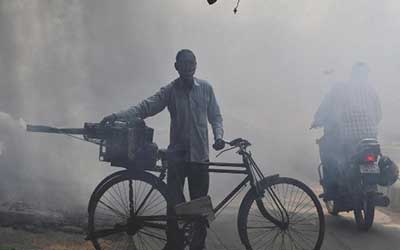Date: 26/04/2023
Relevance: GS-2: Welfare schemes for vulnerable sections of the population by the Centre and States and the performance of these schemes; mechanisms, laws, institutions and Bodies constituted for the protection and betterment of these vulnerable sections.
Key Phrases: Notifiable Disease, Vector-Borne Disease, Ministry Of Tribal Affairs, Malaria Elimination, HIP-Malaria Portal, World Health Organisation, South-East Asia.
Context:
- The aim of making India malaria-free by 2027 has led to the
decision to require cases to be reported to government authorities.
- The Health Ministry aims to eliminate malaria in India by 2030, and this move is part of its vision to achieve this goal.
Key Highlights
- Malaria is a potentially life-threatening disease caused by
parasites that are transmitted through the bite of infected female
Anopheles mosquitoes.
- The disease can cause fever, chills, headaches, and flu-like symptoms. In severe cases, it can cause organ failure, coma, and death.
- According to the World Health Organization (WHO), malaria is
responsible for around 409,000 deaths globally each year.
- Currently, malaria is a notifiable disease in 33 States and Union Territories in India.
India's Progress in Malaria Elimination
- India has made significant progress in eliminating malaria in
recent years.
- The Health Minister recently said that India is the only high-burden, high-impact country in the South-East Asia region to report a decline in malaria cases in 2020 as compared to 2019.
- India witnessed an 85.1% decline in malaria cases and an 83.36%
decline in deaths during 2015-2022.
- These figures are encouraging, but there is still a long way to go to achieve the goal of eliminating malaria in India.
- Real-Time Data Monitoring: The Health Ministry has implemented an
integrated health information platform (HIP-Malaria Portal) that enables
near-real time data monitoring of malaria cases.
- This allows the government to keep track of malaria growth across India and take appropriate action to prevent its spread.
National Framework for Malaria Elimination
- The aims of the National Framework for Malaria Elimination in
India 2016-2030 are:
- To eliminate malaria (zero indigenous cases) throughout the entire country by 2030; and
- Maintain malaria-free status in areas where malaria transmission has been interrupted and prevent re-introduction of malaria.
Objectives:
- Eliminate malaria from all 26 States including 15 low (Category 1) and 11 moderate (Category 2) transmission States/Union Territories (UTs) by 2022;
- Reduce the incidence of malaria to less than 1 case per 1000 population per year in all States and UTs and their districts by 2024;
- Interrupt indigenous transmission of malaria throughout the entire country, including all 10 high transmission States and Union Territories (Category 3) by 2027; and
- Prevent the re-establishment of local transmission of malaria in areas where it has been eliminated and maintain national malaria-free status by 2030 and beyond.
Joint Action Plan with the Ministry of Tribal Affairs
- The Health Ministry has initiated a joint action plan with the
Ministry of Tribal Affairs for malaria elimination in tribal areas.
- Tribal areas in India are often remote and difficult to access, which makes them particularly vulnerable to malaria.
- The joint action plan aims to improve the prevention, diagnosis, and treatment of malaria in these areas.
Global Efforts to Eliminate Malaria
- World Health Organisation’s regional director, South-East Asia, has urged countries affected by malaria in this region to accelerate the reach of high-impact tools and strategies to prevent, detect and treat malaria.
- She emphasized the need to reach at-risk and vulnerable
populations with currently available strategies and tools.
- Malaria is more prevalent among young children whose mothers have a lower level of education and live in rural areas.
- Reaching these populations with available malaria prevention, diagnosis, and treatment is critical for achieving the global technical strategy for malaria 2016-2030 and Sustainable Development Goal targets.
Conclusion
- Malaria is a serious public health issue in India and affects vulnerable populations disproportionately. The government's move to make malaria a notifiable disease across India is a positive step towards eliminating the disease.
- The Health Ministry's joint action plan with the Ministry of Tribal Affairs and the implementation of the HIP-Malaria Portal will help to prevent the spread of malaria and improve the prevention, diagnosis, and treatment of the disease.
- India's progress in eliminating malaria is encouraging, but there
is still much work to be done to achieve the goal of eliminating the disease
by 2030.
- Global efforts to eliminate malaria are also necessary to ensure that no person or population is left behind.
Source: The Hindu
Mains Question:
Q. Despite progress made in recent years, malaria remains a significant public health issue in India, particularly for vulnerable populations. How can the government and healthcare system in India work together to further improve malaria prevention, diagnosis, and treatment, and what role can individuals and communities play in this effort? (250 words).






















